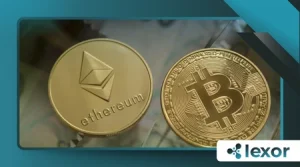Bitcoin vs Ethereum: What’s the Real Difference?

The Bitcoin vs Ethereum debate isn’t just about two cryptocurrencies t’s a clash of ideologies, technological philosophies, and visions for the future of finance.
Bitcoin, the pioneer, was designed as an alternative to fiat money, a digital gold immune to inflation and centralized control.
Ethereum, the innovator, redefined blockchain’s potential by introducing programmable contracts, enabling everything from decentralized finance (DeFi) to digital identity solutions.
But beyond the surface-level comparisons, what truly separates these giants? Is one inherently superior, or do they serve fundamentally different purposes in an evolving digital economy?
As of 2025, Bitcoin remains the undisputed leader in market capitalization, with institutional adoption reaching unprecedented levels.
Ethereum, meanwhile, has solidified its position as the backbone of Web3, hosting over 80% of all decentralized applications.
Their differences extend far beyond price charts—they represent divergent approaches to security, scalability, governance, and even societal impact.
Let’s dissect these contrasts in depth, examining real-world implications for investors, developers, and everyday users navigating the crypto landscape.
Philosophy and Purpose: Digital Gold vs. Programmable Economy
Bitcoin was conceived as a response to the 2008 financial crisis, offering a trustless, censorship-resistant form of money.
Its design prioritizes simplicity and security, with a fixed supply ensuring scarcity. Unlike fiat currencies, which central banks can inflate indefinitely, Bitcoin’s 21 million cap makes it a deflationary asset—akin to digital real estate.
This philosophy attracts long-term holders, from hedge funds to nation-states like El Salvador, which adopted it as legal tender in 2021.
Ethereum, by contrast, was never meant to be just money. Vitalik Buterin envisioned a global computer where developers could build unstoppable applications.
Smart contracts—self-executing agreements written in code—enable everything from lending protocols (Aave) to NFT marketplaces (OpenSea).
While Bitcoin’s community debates minor protocol upgrades, Ethereum’s ecosystem thrives on rapid iteration.
The 2022 Merge, which transitioned Ethereum to Proof-of-Stake, exemplifies this ethos: a monumental shift executed to improve scalability and sustainability.
Example: Imagine Bitcoin as Switzerland’s gold reserves—static, secure, and universally recognized.
+Smart Bathrooms: Yes, They Exist — and They’re Amazing
Ethereum, meanwhile, resembles Silicon Valley—a dynamic hub where startups (dApps) compete and innovate daily. One preserves wealth; the other creates it.
Technology and Scalability: Security vs. Speed
Bitcoin’s Proof-of-Work (PoW) consensus is deliberately slow, prioritizing security over speed.
Miners expend massive computational power to validate transactions, making attacks prohibitively expensive.
This robustness comes at a cost: Bitcoin processes just 7 transactions per second (TPS) on its base layer.
Solutions like the Lightning Network help, but they require users to lock funds in payment channels—a trade-off not all are willing to make.
Ethereum’s shift to Proof-of-Stake (PoS) slashed energy consumption by 99.95%, addressing a major criticism.
But the real breakthrough came with layer-2 rollups (Optimism, Arbitrum) and sharding, which collectively boosted throughput to over 100,000 TPS.
For context, Visa handles ~24,000 TPS—Ethereum now surpasses traditional finance in raw capacity. However, this complexity introduces fragility.
The 2023 outage of a major staking provider exposed risks in over-reliance on a few validators.
++VR and interior design: visualizing spaces before building
Statistic: According to Electric Capital’s 2024 Developer Report, Ethereum attracts 4x more developers than Bitcoin, with over 5,000 monthly active contributors.

Use Cases and Adoption: Preservation vs. Innovation
Bitcoin’s primary use case—store of value—has gained mainstream validation. Corporations like MicroStrategy hold over 1% of Bitcoin’s total supply, treating it as a treasury reserve asset.
Even Goldman Sachs now offers Bitcoin-collateralized loans, signaling institutional trust.
In hyperinflationary economies like Argentina, citizens increasingly use Bitcoin to preserve purchasing power, bypassing crumbling local currencies.
Ethereum’s utility is far more diverse. DeFi platforms built on Ethereum facilitate over $100 billion in locked value, enabling permissionless lending, trading, and yield farming.
The rise of real-world asset (RWA) tokenization—where everything from real estate to carbon credits is digitized further expands its reach.
JPMorgan’s Onyx network, for instance, uses Ethereum-compatible tech to settle interbank transactions.
Read more: How Technology is Helping Kids with Special Needs Learn Better
Analogy: Bitcoin is the foundation of a house—solid, unchanging, and essential. Ethereum is the electrical wiring, plumbing, and smart home system—invisible but enabling modern functionality.
Security and Decentralization: Battle-Tested vs. Evolving
Bitcoin’s decentralization is unmatched. Its 16,000+ global nodes ensure no single entity controls the network.
Even China’s 2021 mining ban—which saw 50% of hash rate go offline—failed to disrupt operations. This resilience makes Bitcoin the safest bet for ultra-long-term holdings.
Ethereum’s PoS, while efficient, leans on a smaller set of validators. Just three entities control ~40% of staked ETH, raising concerns about cartelization.
The network’s social consensus—where developers can forcibly revert hacks—also contrasts with Bitcoin’s immutability.
The 2016 DAO bailout remains controversial, highlighting Ethereum’s willingness to prioritize pragmatism over purity.
Economic Models: Scarcity vs. Flexibility
Bitcoin’s monetary policy is algorithmic perfection. Halvings every four years reduce new supply, creating predictable scarcity. Post-2140, no new Bitcoin will exist—a feature that appeals to gold bugs and anti-inflationists alike.
Ethereum’s economics are more nuanced. The 2023 EIP-1559 upgrade introduced fee burning, making ETH deflationary during high usage.
However, validator rewards still introduce new ETH, and the lack of a hard cap means inflation could return if activity slows.
Regulatory Challenges: Clarity vs. Uncertainty
Bitcoin benefits from regulatory clarity. The SEC and CFTC classify it as a commodity, greenlighting ETFs and futures.
Even stringent regimes like the EU’s MiCA framework treat Bitcoin favorably due to its decentralized nature.
Ethereum walks a tighterrope. The SEC’s 2024 attempt to label ETH a security stalled but wasn’t dismissed. Should enforcement intensify, U.S.-based staking services could face existential threats—a risk priced into ETH’s volatility.
Developer Activity: Stability vs. Experimentation (Bitcoin vs Ethereum)
Bitcoin’s development is conservative by design. Proposals like Taproot (2021) take years to implement, ensuring backward compatibility.
This stability suits its role as money but frustrates builders seeking advanced functionality.
Ethereum’s developer culture thrives on change. The upcoming “Verkle Trees” upgrade will further optimize storage, showcasing its relentless pursuit of scalability.
But rapid evolution has downsides—dApps sometimes break during hard forks, and gas fees remain a pain point.
Cultural Influence: Maximalism vs. Pluralism
Bitcoin maximalists, like MicroStrategy’s Michael Saylor, view altcoins as distractions—or outright scams. Their mantra: “There is no second best.” This ideological purity fosters unity but discourages adaptation.
Ethereum’s community celebrates diversity. From DAO governance to NFT artists, its tent includes anarchists, Fortune 500 companies, and everyone in between.
This inclusivity drives innovation but can lead to fragmentation—witness the dozens of competing layer-2 solutions.
Future Trajectories: Convergence or Divergence?
Will Bitcoin and Ethereum evolve toward each other, or will their differences deepen? Bitcoin’s Lightning Network now supports “Fedimints” community custody pools that enable Ethereum-like smart contracts.
Meanwhile, Ethereum’s rollups increasingly resemble Bitcoin’s layered security model.
Yet their core identities seem immutable. Bitcoin will likely remain the preferred asset for sovereign wealth funds and retirement accounts.
Ethereum, conversely, will continue powering the internet’s next iteration—whether through AI-driven smart contracts or tokenized equity markets.
Frequently Asked Questions: Bitcoin vs Ethereum
Which is better for long-term holding, Bitcoin or Ethereum?
Bitcoin’s scarcity and institutional adoption make it the safer store of value. Ethereum offers higher growth potential but carries more technological and regulatory risk.
Can Ethereum surpass Bitcoin in market cap?
It briefly did in 2021 during DeFi mania, but Bitcoin’s simpler value proposition has since restored its lead. Future flippings aren’t impossible but would require Ethereum to dominate multiple industries.
Why does Bitcoin have slower transaction times?
By design. Its PoW consensus prioritizes security and decentralization over speed. Layer-2 solutions like Lightning Network enable faster payments without compromising base-layer integrity.
Is Ethereum’s PoS really more centralized than Bitcoin’s PoW?
Currently, yes. Just 3 entities control a plurality of staked ETH, whereas Bitcoin’s mining is distributed across thousands of independent operators.
